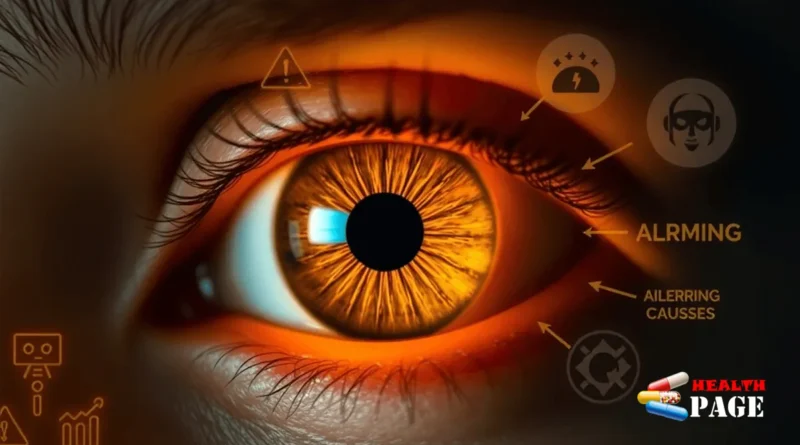7 Alarming Causes of Yellow Sclera You Should Never Ignore
Have you noticed a yellow tinge in the whites of your eyes? This condition, known as yellow sclera or scleral icterus, demands immediate attention as it signals potential underlying health issues.
The human eye’s white part (sclera) serves as a natural warning system for various health conditions. When these pristine whites turn yellow, it’s your body raising a red flag that requires swift medical evaluation.
This yellowing occurs due to a substance called bilirubin – a yellow compound produced during the natural breakdown of red blood cells. A healthy liver processes this bilirubin efficiently. When this process faces disruption, bilirubin builds up in your bloodstream, leading to jaundice.
Key Signs of Yellow Sclera:
- Yellowish discoloration of eye whites
- Skin taking on a yellow hue
- Dark-colored urine
- Light or clay-colored stools
- Unexplained fatigue
Yellow sclera acts as an early warning sign of jaundice, a condition affecting people across all age groups. From newborns to adults, this yellowing can indicate various health concerns ranging from mild to severe.
Understanding these potential causes empowers you to take control of your health. Let’s explore 7 critical conditions that could be behind your yellow sclera, each requiring specific medical attention and treatment approaches.
1. Liver Diseases
The liver is your body’s natural filtration system, processing bilirubin from broken-down red blood cells. When liver diseases occur, this important process is disrupted.

Common liver conditions affecting bilirubin processing include:
- Viral Hepatitis: This inflammatory condition damages liver cells, disrupting their ability to process bilirubin
- Cirrhosis: Scarring of liver tissue impairs normal liver function, leading to bilirubin buildup
- Liver Cancer: Tumors can block bile ducts and interfere with bilirubin metabolism
- Alcoholic Liver Disease: Excessive alcohol consumption damages liver cells
The connection between liver dysfunction and yellowing of the eyes (sclera) is straightforward. As liver damage worsens, bilirubin levels increase in the bloodstream.
A healthy liver processes about 250-350 mg of bilirubin daily. Liver diseases can reduce this capacity by up to 75%.
Signs of liver-related yellowing of the eyes:
- Gradual yellowing that starts in the eyes
- Darkening urine color
- Light-colored stools
- Skin itching
- Abdominal pain
Liver diseases affect bilirubin processing in several ways:
- Direct damage to liver cells reduces their ability to process bilirubin
- Inflammation blocks small bile ducts within the liver
- Scarring disrupts normal blood flow through liver tissue
- Tumors create physical barriers in bile flow
The severity of yellowing of the eyes often reflects the extent of liver damage. Early detection allows for better treatment outcomes through:
- Antiviral medications for hepatitis
- Lifestyle changes to prevent further damage
- Targeted therapies for liver cancer
- Management of cirrhosis complications
Specific blood tests can measure different forms of bilirubin, helping doctors determine the type and severity of liver disease causing yellowing of the eyes.
2. Gallbladder and Bile Duct Disorders
Your gallbladder and bile ducts play a crucial role in processing and transporting bile throughout your digestive system. Any disruption to this delicate system can trigger yellow sclera.
Common Gallbladder Blockages:
- Gallstones – Hard deposits that form in your gallbladder
- Inflammation (cholecystitis) – Swelling that narrows bile ducts
- Tumors – Both benign and malignant growths
- Cysts – Fluid-filled sacs that compress surrounding tissues
These blockages create a “traffic jam” effect in your bile ducts. Bile backs up into your bloodstream instead of flowing to your intestines.
Bile Duct Diseases That Cause Yellow Sclera:
- Primary Sclerosing Cholangitis (PSC)
- Scarring and hardening of bile ducts
- Progressive damage to the biliary system
- Biliary Atresia
- Missing or damaged bile ducts
- Common in newborns
- Requires immediate medical attention
When bile can’t flow freely through these channels, bilirubin levels rise rapidly in your blood. This excess bilirubin seeks alternative paths through your body, settling in various tissues – including your eye’s sclera.
Warning Signs of Bile Flow Problems:
- Dark urine
- Light-colored stools
- Upper right abdominal pain
- Unexplained itching
- Fatigue
- Loss of appetite
The appearance of yellow sclera from gallbladder or bile duct disorders often develops gradually. This slow progression can make it easy to overlook early warning signs.
Your doctor can use several diagnostic tools to identify these blockages:
- Ultrasound imaging
- CT scans
- Blood tests
- ERCP (Endoscopic Retrograde Cholangiopancreatography)
Early detection allows for more treatment options, ranging from medication to surgical intervention. Some cases might require complete gallbladder removal or bile duct repair.
3. Pancreatic Issues
Your pancreas plays a vital role in digestive health, sitting right behind your stomach. This organ’s location near bile ducts makes pancreatic problems a significant cause of yellow sclera.
Pancreatic disorders can create a domino effect leading to yellow eyes through different mechanisms:
- Acute Pancreatitis: Sudden inflammation blocks bile flow, creates pressure on surrounding bile ducts, and causes rapid bilirubin buildup in blood.
- Chronic Pancreatitis: Long-term inflammation damages pancreatic tissue, leads to scarring around bile ducts, and results in persistent bile flow problems.
- Pancreatic Cancer: Tumors compress nearby bile ducts, disrupt normal bile movement, and create progressive yellowing of eyes.
The relationship between pancreatic health and yellow sclera becomes clear through these specific symptoms:
- Dark urine
- Light-colored stools
- Upper abdominal pain
- Unexplained weight loss
- Nausea or vomiting
Pancreatic conditions often show these warning signs:
Early Stage:
- Mild eye yellowing
- Subtle digestive changes
- Occasional discomfort
Advanced Stage:
- Intense yellow sclera
- Severe abdominal pain
- Significant weight changes
Risk factors increasing your chances of pancreatic issues include:
- Heavy alcohol consumption
- Smoking
- Family history
- Obesity
- Diabetes
Your doctor might use these diagnostic tools to identify pancreatic problems:
- Blood tests
- CT scans
- MRI imaging
- Endoscopic ultrasound
- Biopsy procedures
4. Blood Disorders
Blood disorders can cause yellowing of the eyes due to their effect on red blood cell breakdown. The body naturally recycles old red blood cells, but certain blood conditions can speed up this process and lead to an excess production of bilirubin.
Specific blood conditions that can accelerate red blood cell breakdown include:
1. Hemolytic Anemia
In this condition, red blood cells are destroyed prematurely, resulting in a rapid breakdown that overwhelms the liver’s ability to process bilirubin. As a consequence, bilirubin accumulates in the blood vessels and causes yellowing of the sclera.
2. Sickle Cell Anemia
Sickle Cell Anemia is characterized by abnormal hemoglobin that causes red blood cells to become misshapen. These misshapen cells break down more quickly than normal cells, leading to a constant elevation of bilirubin levels and potentially causing recurring episodes of yellow sclera.
3. Blood Transfusion Reactions
When incompatible blood types are transfused, the immune system launches an attack on the transfused red blood cells. This immune response results in the rupture of the attacked cells and the release of excess bilirubin into circulation, which can cause a sudden onset of yellow sclera requiring immediate medical attention.
The severity of eye yellowing often reflects the intensity of the underlying blood disorder. Mild cases may exhibit subtle discoloration, while severe conditions can result in bright yellow coloration.
Blood disorders affect bilirubin levels through various mechanisms:
- Direct destruction of red blood cells
- Accelerated breakdown of red blood cells
- Immune system responses against transfused or abnormal cells
- Genetic alterations in cell structure leading to increased fragility
Treatment approaches differ based on the specific blood disorder diagnosed:
- Regular blood transfusions for conditions like Sickle Cell Anemia
- Iron chelation therapy to manage iron overload from repeated transfusions
- Bone marrow transplants as a potential cure for certain genetic disorders
- Medications aimed at boosting red blood cell production in cases of anemia
Identifying the exact blood disorder requires specialized tests such as:
- Complete blood count (CBC) to assess overall red blood cell health
- Blood smear examination to look at the shape and size of individual cells
- Hemoglobin analysis to identify any abnormalities in hemoglobin structure
- Genetic testing for inherited conditions affecting red blood cell production or survival
Regular medical check-ups with these diagnostic tests can help detect these blood disorders early on, preventing severe complications associated with elevated bilirubin levels and jaundice.
5. Genetic Disorders
Inherited genetic conditions can significantly impact liver function and bilirubin processing, leading to yellow sclera. These disorders often manifest through specific genetic mutations passed down through families.
Gilbert Syndrome
Gilbert Syndrome affects up to 5% of the population. This inherited condition reduces the liver’s ability to process bilirubin by 30%. People with Gilbert Syndrome experience:
- Mild jaundice during periods of stress
- Fatigue and weakness
- Occasional abdominal discomfort
- Symptoms that worsen with:
- Dehydration
- Fasting
- Lack of sleep
- Illness
Dubin-Johnson Syndrome
Dubin-Johnson Syndrome creates a rare genetic mutation affecting bilirubin transport proteins. The condition causes:
- Dark liver pigmentation
- Chronic mild jaundice
- Occasional right-sided abdominal pain
- Delayed bilirubin clearance from blood
Wilson’s Disease
Wilson’s Disease disrupts copper metabolism through a genetic defect. This dangerous condition leads to:
- Copper accumulation in vital organs
- Progressive liver damage
- Neurological symptoms
- Vision changes
- Yellow sclera as liver function declines
Porphyrias
Porphyrias represent a group of genetic disorders affecting heme production. These conditions cause:
- Buildup of porphyrins in body tissues
- Acute attacks with severe symptoms
- Skin photosensitivity
- Liver dysfunction
- Varying degrees of jaundice
Genetic testing plays a crucial role in diagnosing these inherited conditions. Each disorder requires specific management strategies:
- Regular monitoring of bilirubin levels
- Dietary modifications
- Medication adjustments
- Lifestyle changes
- Genetic counseling for family planning
Early identification allows proper management of these genetic conditions, preventing severe complications and maintaining quality of life.
6. Infections
Infections are a major cause of yellowing eyes, with both viruses and parasites capable of causing serious damage to liver health. The connection between infections and jaundice symptoms creates a complex network of health issues that require attention.
Viral Hepatitis Types:
- Hepatitis A – spreads through contaminated food/water
- Hepatitis B – transmitted via blood, bodily fluids
- Hepatitis C – often contracted through shared needles
- Hepatitis D – requires presence of Hepatitis B
- Hepatitis E – common in areas with poor sanitation
These viruses attack liver cells directly, disrupting their ability to process bilirubin. The resulting inflammation triggers a cascade of symptoms, including the characteristic yellowing of the eyes.
Parasitic Infections
Certain parasites target the liver and bile ducts:
- Liver flukes – tiny flatworms that inhabit bile ducts
- Schistosomiasis – parasitic worms affecting liver blood vessels
- Malaria – destroys red blood cells, overwhelming liver function
The damage from these infections can manifest in several ways:
- Direct liver cell destruction
- Bile duct obstruction
- Increased red blood cell breakdown
- Chronic inflammation
- Scarring of liver tissue
Early detection plays a crucial role in preventing permanent liver damage. Signs that may accompany yellow sclera during infections include:
- Fever and chills
- Abdominal pain
- Loss of appetite
- Dark urine
- Fatigue
- Joint pain
The severity of infection-related yellow sclera varies based on:
- The specific pathogen involved
- Duration of infection
- Patient’s immune status
- Pre-existing liver conditions
- Time between infection onset and treatment
Proper diagnosis requires comprehensive testing, including blood work, imaging studies, and sometimes tissue samples to identify the exact infectious agent causing the 7 Alarming Causes of Yellow Sclera You Should Never Ignore.
7. Newborn Jaundice
Newborn jaundice affects up to 60% of full-term babies during their first week of life. This common condition stems from temporary bilirubin accumulation in a newborn’s developing body.
A newborn’s liver faces unique challenges as it adapts to life outside the womb:
- Immature liver enzyme systems need time to develop full functionality
- Higher red blood cell count at birth leads to increased bilirubin production
- Shorter red blood cell lifespan creates additional bilirubin processing demands
- Limited milk intake in early days slows bilirubin elimination
The yellowing typically appears:
- First in the face
- Progresses to the chest
- Moves down to the abdomen
- Reaches the legs in severe cases
Most cases resolve naturally within 2-3 weeks as the baby’s liver matures. However, certain factors increase jaundice risk:
- Premature birth
- Blood type differences between mother and baby
- Bruising during delivery
- Certain genetic conditions
- Poor feeding patterns
Regular monitoring proves essential to prevent rare but serious complications:
Kernicterus, a form of brain damage, can occur when bilirubin levels rise too high. This condition requires immediate medical intervention.
Healthcare providers track bilirubin levels through:
- Visual assessments
- Skin tests using special devices
- Blood samples when needed
Treatment options include:
- Phototherapy – Special blue lights help break down bilirubin
- Supplemental feeding – Increases bilirubin elimination
- Blood exchange transfusion – Reserved for severe cases
Parents should watch for:
- Yellowing spreading down the body
- Poor feeding patterns
- Unusual sleepiness
- High-pitched crying
- Changes in muscle tone
Importance of Prompt Medical Evaluation
Yellow sclera is an important warning sign that requires immediate medical attention. This symptom could indicate serious underlying health issues affecting your liver, blood, or other vital organs.
Diagnosis Tests Used by Medical Professionals
To identify the root cause of yellow sclera, medical professionals use various diagnosis tests such as:
- Blood tests to measure bilirubin levels and assess liver function
- Imaging studies like ultrasounds or CT scans
- Liver biopsy in specific cases
- Genetic testing when hereditary conditions are suspected
Treatment Options Based on Identified Cause
The range of treatment options available depends on the identified cause:
- Antiviral medications for hepatitis infections
- Surgical procedures for gallbladder or bile duct blockages
- Blood transfusions for certain blood disorders
- Phototherapy for newborn jaundice
- Lifestyle modifications, including dietary changes
- Regular monitoring of liver function
Early detection through prompt medical evaluation significantly improves treatment outcomes for the 7 Alarming Causes of Yellow Sclera You Should Never Ignore.
Personalized Treatment Plan by Healthcare Provider
Your healthcare provider will create a personalized treatment plan based on:
- Severity of symptoms
- Underlying medical conditions
- Age and overall health status
- Presence of complications
- Response to initial treatments
Remember: Yellow sclera isn’t just a cosmetic concern – it’s your body’s way of signaling potential health issues that require professional medical assessment.
FAQs (Frequently Asked Questions)
What is yellow sclera and why is it important to recognize?
Yellow sclera, also known as scleral icterus, refers to the yellowing of the white part of the eyes. It is an important health indicator because it often signals jaundice, which results from bilirubin buildup in the body and may indicate underlying medical conditions.
How do liver diseases cause yellow sclera?
Liver diseases such as hepatitis, cirrhosis, and liver cancer impair the liver’s ability to process bilirubin effectively. This dysfunction leads to bilirubin accumulation in the bloodstream, causing jaundice and resulting in yellowing of the sclera.
Can gallbladder or bile duct disorders lead to yellow sclera?
Yes, disorders like gallstones, cholecystitis, and bile duct obstructions block normal bile flow. This blockage causes bilirubin to accumulate in the body, leading to jaundice and yellow sclera.
What role do pancreatic issues play in developing yellow sclera?
Pancreatic problems such as pancreatitis or pancreatic cancer can obstruct bile ducts. This obstruction hinders bile flow and causes bilirubin buildup, which manifests as yellowing of the eyes.
Are genetic disorders linked to yellow sclera?
Certain genetic conditions like Gilbert syndrome, Dubin-Johnson syndrome, Wilson’s disease, and porphyrias affect liver function and bilirubin metabolism. These can lead to elevated bilirubin levels and result in yellow sclera.
Why is prompt medical evaluation crucial when yellow sclera is noticed?
Yellow sclera can indicate serious underlying health issues including liver disease, infections, or blood disorders. Timely diagnosis through appropriate tests allows for effective treatment options and prevents complications associated with elevated bilirubin levels.


